|
Felles for alle mikroskopkameraene:
|
Color Aptina MT9F002(Progressive) CMOS Sensor USB3.0 C-Mount CMOS Camera.
Square Housing:68 X 68 X 45mm. Support Microsoft Windows XP / Vista / 7 /8 (32 & 64 bit) and OS X (MAC OS X) and Linux. Support Native C/C++, C#, Directshow, Twain, Labview.
|
|
Operating Temperature |
-10℃~ 50℃ |
|
Storage Temperature |
-20℃~ 60℃ |
|
Operating Humidity |
30~80%RH |
|
Storage Humidity |
10~60%RH |
|
Power Supply |
DC 5V over PC USB Port |
|
|
Operating System |
Support Microsoft Windows XP / Vista / 7 /8 (32 & 64 bit)
OS X (Mac OS X), Linux |
|
PC Requirements |
CPU: Equal to Intel Core2 2.8GHz or Higher |
|
Memory: 2GB or More |
|
USB port: USB2.0 High-speed Port |
|
Display: 17" or Larger |
|
CD-ROM |
|
White balance |
ROI White Balance/ Manual Temp-Tint Adjustment |
|
Color Rendering Technique |
Ultra Fine Color Engine |
|
Peak Quantum Efficiency |
NA |
|
Readout Noise |
N/A |
|
Extinction Ratio |
N/A |
|
Smear |
N/A |
|
Capture/Control API |
Native C/C++, C#, Directshow, Twain, Labview |
|
Recording System |
Still Picture and Movie |
|
Cooling System* |
Natural |
|
14MP CMOS spesifikasjon |
|
Image Pickup Device |
Aptina MT9F002 CMOS (Color) |
|
Scan Mode |
Progressive |
|
Max. Resolution |
4096 x 3288 (Approx. 14,000,000 Pixels) |
|
Sensor Size (Diagonal) |
1/2.3“ (6.138mm(H) x 4.603mm(V), Diagonal 7.672mm) |
|
Pixel Size |
1.4μm x 1.4μm |
|
G Sensitivity |
0.724v/lux-sec(550nm) |
|
Dynamic Range |
65.3dB |
|
A/D Converter |
12-bit Parallel, 8-bit R.G.B to PC |
|
SN Ratio |
35.5dB |
|
Spectral Range |
380-650nm (with IR-filter) |
|
Video Format & Frame Rate |
6.2fps @4096 x 3286, 21fps @2048 x 1644, 54fps @1024 x 822 |
|
Binning |
1 x 1, 2 x 2, 4 x 4 |
|
Exposure |
0.4~2000ms, ROI Auto & Manual |
|
|
|
|
|
|
|
|
|
|
10MP CMOS spesifikasjon |
|
Image Pickup Device |
APTINA MT9J003 CMOS Sensor(Color) |
|
Scan Mode |
Progressive |
|
Max. Resolution |
3584 x 2748 (Approx. 10,000,000 Pixels) |
|
Sensor Size (Diagonal) |
1/2.2“ (6.119mm(H) x 4.589mm(V), Diagonal 7.649mm) |
|
Pixel Size |
1.67µm x 1.67µm |
|
G Sensitivity |
0.31v/lux-sec(550nm) |
|
Dynamic Range |
65.2dB |
|
A/D Converter |
12-bit Parallel, 8-bit R.G.B to PC |
|
SN Ratio |
34dB |
|
Spectral Range |
380-650nm (with IR-filter) |
|
Video Format & Frame Rate |
7.2fps @3584 x 2746, 25fps @1792 x 1372 (Multiple Speed Level) |
|
Binning |
1 x 1, 2 x 2, 4 x 4 |
|
Exposure |
0.38~2000ms, ROI Auto & Manual |
|
5MP CMOS spesifikasjon |
|
Image Pickup Device |
Aptina MT9P006 CMOS(Color) |
|
Scan Mode |
Progressive |
|
Max. Resolution |
2560 x 1922 (Approx.5,000,000 Pixels) |
|
Sensor Size (Diagonal) |
1/2.5“ (5.70mm(H) x 4.28mm(V), Diagonal 7.13mm) |
|
Pixel Size |
2.2µm x 2.2µm |
|
Imageing Area |
5.632mm(H) x 4.228mm(V) |
|
Responsivity |
01.76v/lux-sec(550nm) |
|
Dynamic Range |
67.74dB |
|
A/D Converter |
12-bit Parallel, 8-bit R.G.B to PC |
|
SN Ratio |
38.5dB |
|
Spectral Range |
380-650nm (with IR-filter) |
|
Video Format & Frame Rate |
14.5fps @2560 x 1922, 39fps @1280 x 960, 101fps @640 X 480 |
|
Binning |
1 x 1, 2 x 2, 4 x 4 |
|
Exposure |
0.05ms~2s, ROI Auto & Manual |
|
3,1MP CMOS ULTRA SPEED spesifikasjon |
|
Image Pickup Device |
Aptina AR0330 CMOS Sensor(Color) |
|
Scan Mode |
Progressive |
|
Max. Resolution |
2048 x 1536 (Approx.3,200,000 Pixels) |
|
Sensor Size (Diagonal) |
1/3“ (Diagonal 6.0mm) |
|
Pixel Size |
2.2µm x 2.2µm |
|
Responsivity |
2.0v/lux-sec(550nm) |
|
Dynamic Range |
72.4dB |
|
A/D Converter |
12-bit Parallel, 8-bit R.G.B to PC |
|
SN Ratio |
39dB |
|
Spectral Range |
380-650nm (with IR-filter) |
|
Video Format & Frame Rate |
27.4fps @2048 x 1534, 53.3fps @1024 x 770 (Multiple Speed Level) |
|
Binning |
1 x 1, 2 x 2 |
|
Exposure |
0.1ms~2000ms, ROI Auto & Manual |
INKLUDERT SOFTWARE:
 |
|
WHAT’S IN THE INCLUDED SOFTWARE:
TopView is one of our most famous camera control software. It provides functions to fully control the camera and present the videostream processed by Ultra FineTM color engine at high speed, which includes dedicated pipeline to process the raw data into a realistic scene. Besides, diversified useful tools are provided for specific purpose, such as luminance calibration, measurement, image stitching, extending depth of field, video watermark attachment, color composition, imaging processing and so on. Multi-language mechanism is also realized to support random language, which includes but not limited to English, Chinese, Russian, Turkish, Korea, Polish and so on. Now ToupView is widely used in the field of medical microscopic imaging, industrial detection, machine vision, astronomical observation, etc.
TopView software could be used with other cameras, which support Twain or DirectShow interface. ToupView is one of the best software in the camera industry, and the United States education department is strongly recommend |
Avansert medfølgende software:
Extended Depth of Focus
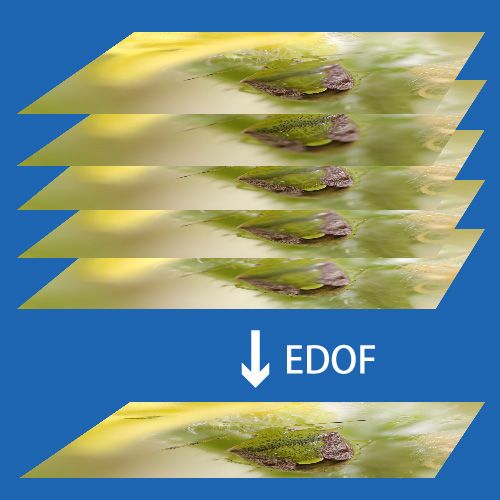 |
TopView for camera
Unlimited language support
32bit or 64bit
Windows XP, Vista, 2008, Win7, Win8
Mac and Liniux
Ultra Fine color engine
Diversified useful tools
Medical microscopic imaging
Industrial detection
Machine vision
Astronomical observation |
|

|
|
Color Composite

Sample Images for Color Composite |
Unlimited language support
32bit or 64bit Windows
XP, Vista, 2008, Win7, Win8
Mac and Liniux
Ultra Fine color engine
Diversified useful tools
Medical microscopic imaging
Industrial detection
Machine vision
Astronomical observation
|
|
Specifications: Color Composite
Combining multiple fluorescent images into a composite is a common practice. Usually, fluorescent wavelengths
are acquired individually and then merged together. And often times it is necessary to acquire and merge a
fluorescent image and an image acquired through brightfield techniques.
For a variety of reasons it is not always possible to acquire the images simultaneously,
so image processing tools are necessary to present a complete and accurate qualitative picture.
Several issues need to be considered when combining fluorescent images. Since images of this type are typically
acquired in a monochrome environment, it is necessary to have tools to colorize the individual images.
Registration issues need to be considered as well, as chromatic shift and other effects may be revealed in
the composite image. Finally, three dimensional fluorescence stacks may need to be merged together into a
composite image to view the interactions of the various fluorochromes with one another.
The Color Composite feature is found in ToupView. It contains functions for the creation, coloration, registration
and contrast enhancement of composite images. Additional features are present to merge image stacks into
three-dimensional and composite images as well as methods to subtract background
The Color Composite tool is used primarily to merge and register multiple fluorescent images acquired as
monochrome single wavelengths into a color composite image. It is also an excellent tool for merging brightfield/fluorescence combinations such as those created using Green Fluorescent Protein (GFP) and
Differential Interference Contrast (DIC) images.
It is important to note Process|Color Composite… returns a 24-bit image. It has been designed as a
visualization tool, and is not intended for quantitative analysis. |
Image Stitching
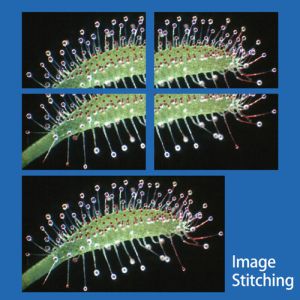 |
Image Stitching
Unlimited language support
32bit or 64bit
Windows XP, Vista, 2008, Win7, Win8
Mac and Liniux
Ultra Fine color engine
Diversified useful tools
Medical microscopic imaging
Industrial detection
Machine vision
Astronomical observation |
Image Stitching
Digital image processing allows us to see immense amounts of detail within an image. Intensity,
spatial and morphometric
details are easily captured and evaluated nowadays thanks to easily affordable, highly sensitive and very precise imaging systems. Coupled with image analysis software programs, extracting quantifiable
information is a snap.
But it is the nature of research to push technology and it is no longer enough to collect and evaluate data
from a single image when multiple images tell a bigger story. Creating a large composite image from several individual acquisitions allows us to see, literally, the bigger picture. Increasingly, it’s the bigger picture we are interested in evaluating.
Fortunately, hardware and software technologies converge perfectly to provide the basis for creating perfectly
aligned tiled and stitched images. The software supports both the image stitching for both the opened images
and the images in browsing window.
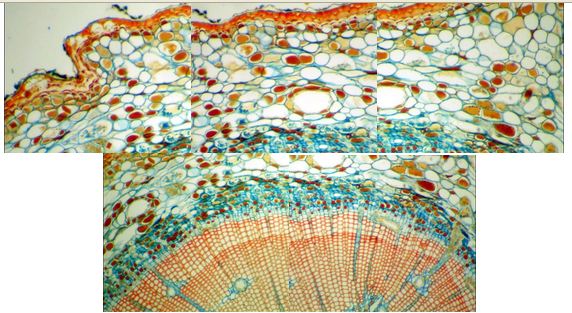
Bilder før Stitching
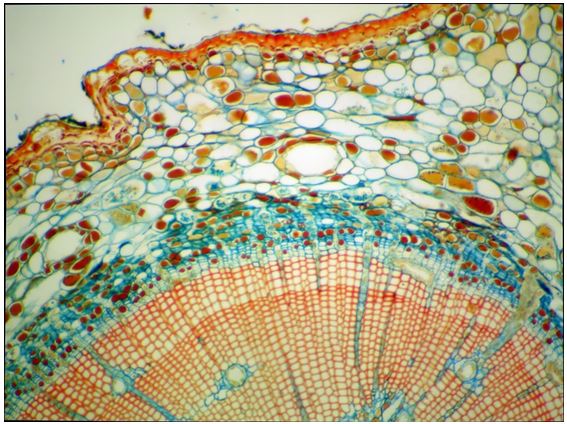
Stitched ferdig
|
|
|
Measurement
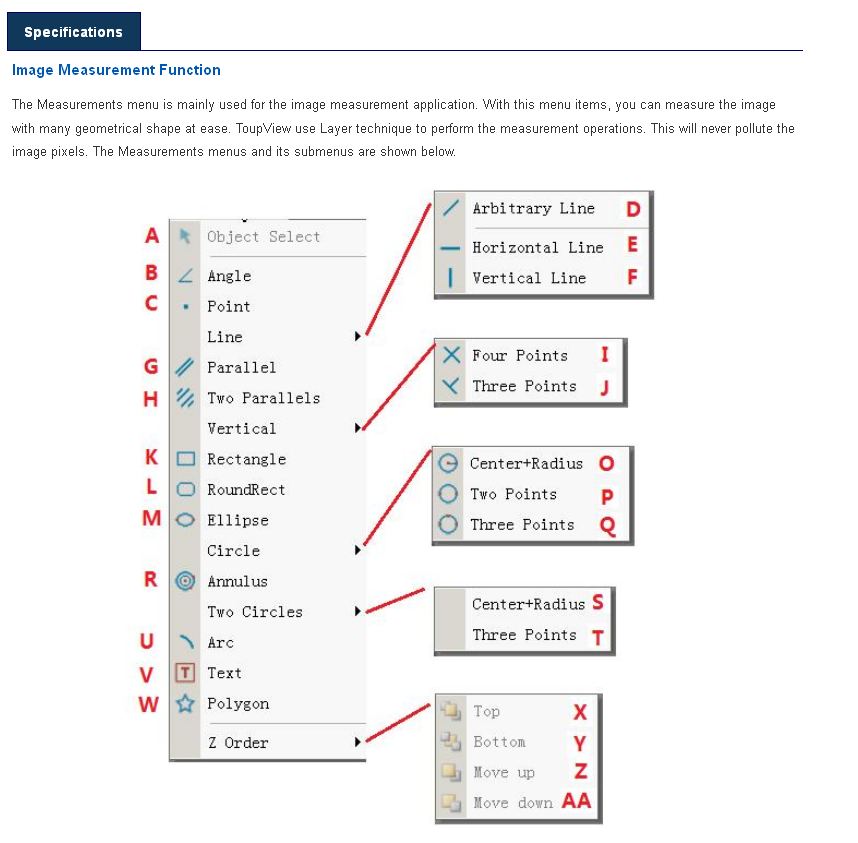
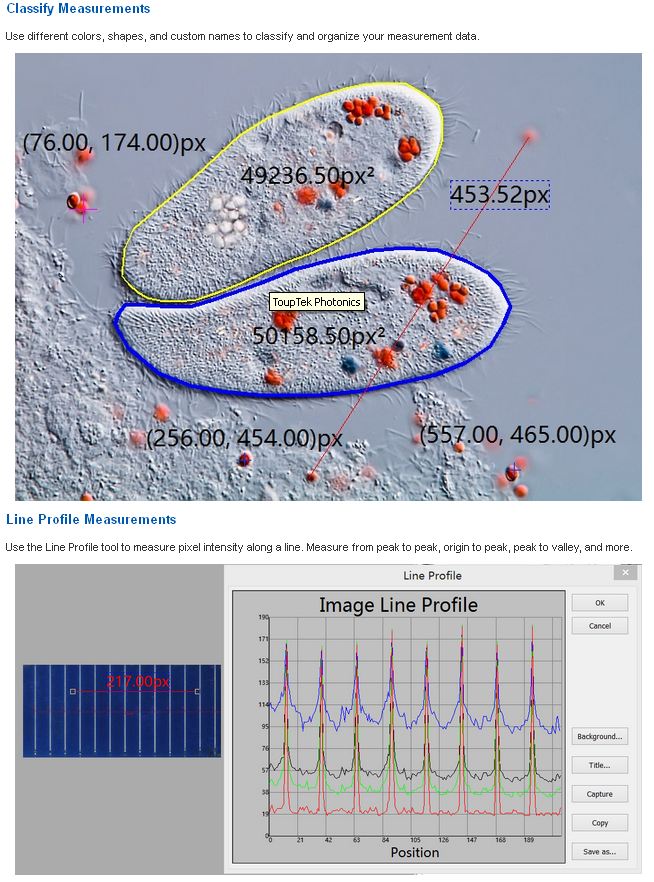
|
Stacking

Why Stacking
The main problem with stars and things you want to photograph is that they're so dim. Very little light reaches the earth from a dim star, so just pointing your camera at the sky and clicking the shutter will only capture a few of the brightest stars. Ideally, you want to leave your shutter open for as long as possible, but there are problems with this.
Firstly, the stars move around the sky, so on any exposure above about 15 seconds the stars will stretch out into curved streaks. This is a cool effect if it's what you're after, but if you want a picture of the sky as it appears to your eyes it's not helpful.
The second problem is that digital cameras pick up stray radio signals, cosmic rays, thermal vibrations and all sorts of other things which aren't starlight.
Thirdly, most cheap digital cameras will only take single exposures for a maximum of 15 or 30 seconds. An SLR with bulb mode will happily leave the shutter open for as long as you want, but this demo that will work with any camera. Fortunately, stacking images can get rid of all of these problems and increase the amount of detail visible in return for a little effort.
How Does It Work?
This step is more about the theory of how stacking works- if you don't care about random distributions and would rather get going, feel free to skip it.
Roll a dice once and you might get any result from 1 to 6. Roll it a thousand times, and you can be pretty sure the results will average out to about 3.5. If the results average to a different value, you can be fairly sure your dice is loaded. There's no way you could know that from a single roll, but by taking the average of lots of rolls you can see the pattern of behaviour. The camera works the same way. If you take a single photo in the dark, it will look speckly. This is because of the random signals, or noise, the sensor picks up. This noise obscures the actual subject of your photo and means you can't tell what is a speckle and what is a dim star.
Taking lots of photos is the equivalent of rolling a dice a lot of times- you are taking a lot of samples of each individual piece of sky and taking the average brightness to eliminate random variations. The average value of a pixel that was pointing at a star will tend to be slightly brighter than a pixel that was pointing at dark sky, but this difference might be smaller than the random variations on any single photo.
In general, the more photos you take, the more uniform the background noise becomes after averaging and the more detail you can pick out. A statistician would say that the averaged photo contains more information than a single exposure- there's more meaningful detail.
Once you've got a composite made of the average of many photos, you can tweak the levels with image editing software so the background is the black you expect from the night sky and the stars stand out.
With ToupView, you do not need to snap the image one by one. You can use the Record function on the control panel to record a video run 1000 or more frames for stacking.
You can download the Video to test the algorithm effectiveness.
Image Stacking
ToupView is doing a few tasks that you can do by hand, but it's incredibly tedious. Firstly it reads the 2 video frames and aligns the two frames so that the stars are in the same place, then stacking it. The two stacked frame as a new frame will be took as the first frame and ToupView will read the 3rd frames, then ToupView will continus do the same alignment operation with this two new frames untill the end Video frame.
LAST NED TOUPTEK DRIVER FOR PC (paket i rar) her
LAST NED TOUPTEKS Instalation Manual i pdf: her
LAST NED TOUPTEKS Software Manual i pdf: her
OPPLÆRINGSVIDEOER PÅ YOUTUBE:
Introduksjon til ToupTek Software: https://www.youtube.com/watch?v=y0zjRFhiWwY
Lær om kalibrering av ToupTek kamera: https://www.youtube.com/watch?v=j9fBjG14P5U
Amscopes introduksjon av Touptek Software: https://www.youtube.com/watch?v=Z8652DG249E
Amscopes ToupTek video om kontoll av rameraten (Fps): https://www.youtube.com/watch?v=7X574Ej--V8 |
Microscopes are Our Business & Service is our pride |









